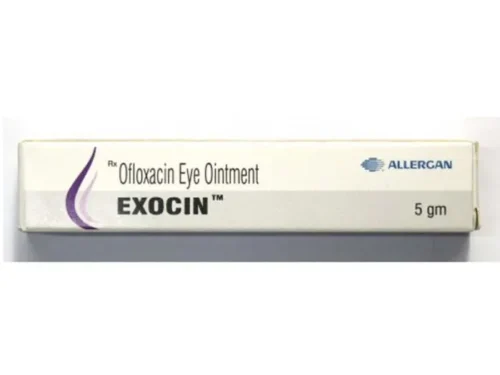Estocin 5 gm
Estocin 5 gm is an ophthalmic antibiotic ointment made for topical use in the eye.
Price range: $15.10 through $80.64
Availability: IN STOCK
Estocin 5 gm is an ophthalmic antibiotic ointment made for topical use in the eye. It is an eye ointment that contains a macrolide antibiotic (azithromycin in many branded formulations). It comes as a sterile ointment in a small tube. The tube size named “5 gm” refers to the net weight of the ointment in the tube. Estocin treats bacterial infections of the surface of the eye. The product is made to be put on the eye’s surface only.
Key Features
| About Estocin 5 gm | |
|---|---|
| Drug Class | Ophthalmic Antibiotic (Macrolide class) |
| Subclass | Topical antibacterial eye ointment (Azithromycin-based formulation) |
| Product Details | |
|---|---|
| Composition | Active ingredient:
Inactive ingredients:
|
| Packaging Type | Tube |
| Pack Size | 5 gm |
| Dosage | Apply a thin ribbon of Estocin 5 gm into the affected eye(s) as directed by your ophthalmologist—typically once or twice daily depending on severity. |
| Therapeutic Class | Ophthalmic antibacterial agent |
| Action Class | Bacteriostatic / bactericidal antibiotic (Macrolide) |
| Chemical Class | Semi-synthetic macrolide derived from erythromycin (Azithromycin derivative) |
| Manufacturer | — |
| Shelf Life | 2 years from manufacturing date (check package for expiry) |
| Usages | For treatment of bacterial conjunctivitis, blepharitis, and other superficial ocular infections caused by susceptible bacteria. Provides longer ocular contact time and local antibacterial action. |
| Country of Origin | India |
| Storage | Store at room temperature (15–30°C), away from moisture and direct sunlight. |
Key features at a glance
- Product: Estocin 5 gm (eye ointment).
- Active antibiotic: azithromycin (macrolide class) in typical formulations.
- Dosage form: sterile ophthalmic ointment.
- Use: bacterial conjunctivitis and other superficial ocular bacterial infections as directed by a clinician.
- Benefits: local action on the eye, limited systemic exposure, and longer contact time on the eye than some drops.
How Estocin 5 gm works
Azithromycin belongs to the macrolide family of antibiotics. It blocks bacterial protein synthesis. This stops bacteria from growing and allows the body to clear the infection. When applied to the eye, Estocin 5 gm concentrates where the infection is. That helps clear bacteria quickly while keeping systemic absorption very low. Macrolides like azithromycin are widely studied and used for eye infections.
Indications / Uses
You should use Estocin 5 gm only when a healthcare provider diagnoses or strongly suspects a bacterial eye infection. Common uses include:
- Bacterial conjunctivitis (pink eye).
- Selected superficial eyelid infections or blepharitis caused by susceptible bacteria.
- Cases where ointment is preferred (for example at night, or when longer contact time is helpful).
Do not use Estocin for viral or allergic conjunctivitis unless a clinician combines it with other treatments. If you are not sure, see an eye care professional.
Typical composition
A manufacturer label for Estocin-type ointments commonly lists:
- Active: azithromycin (amount per gram varies by brand; many ophthalmic ointments contain 10 mg azithromycin per gram equivalent).
- Preservative: small amounts of tolerated preservatives (product labels vary).
- Ointment base: sterile ophthalmic ointment vehicle.
Check the exact product label for your tube. Different makers may use different excipients or exact strengths.
Dosage & How to Use
General steps (follow the product label and your clinician):
- Wash hands well. Always start by washing your hands with soap and water to avoid introducing new bacteria to the eye.
- Tilt head back and pull down lower eyelid to make a small pocket. This pocket will hold the ointment until you close your eyes.
- Squeeze a thin ribbon (small amount) of Estocin 5 gm into the lower eyelid pocket. Use only the amount directed by your doctor. Avoid touching the tube tip to the eye, eyelid, or any surface to keep it sterile.
- Close the eye gently for a few seconds. This helps the ointment spread evenly across the eye’s surface.
- Wipe away any excess ointment with a clean tissue. Discard the tissue immediately to prevent recontamination.
- Replace the cap securely after every use. Keep the tube tightly closed and clean.
- Use for the full recommended course, even if symptoms improve. Do not stop early. Completing the course helps prevent recurrence and antibiotic resistance.
Typical dosing: Ointment dosing may vary depending on your condition and doctor’s directions. Some clinicians advise applying Estocin 5 gm once or twice daily, often at bedtime for convenience and longer contact time. Always follow the instructions given on the label or by your healthcare provider.
Important note: Avoid driving or performing tasks that require clear vision immediately after applying Estocin 5 gm, as temporary blurring may occur for a short time after use.
What to expect (benefits & timeline)
- Many people see symptom relief within 48–72 hours.
- Ointment form can reduce infection and soothe the eye.
- Using the full prescribed course lowers the chance of recurrence and resistance.
- Local therapy limits systemic effects because absorption is low.
Side effects
Common side effects:
- Temporary blurred vision immediately after use.
- Mild stinging or local eye irritation in some people.
- Increased tearing or mild redness for a short time.
Rare side effects:
- Severe eye pain.
- Marked swelling.
- Severe rash.
- Breathing problems.
You should stop the medication and seek immediate medical help. These severe allergic reactions are rare but possible.
Important safety notes
- Do not share the tube with others. Sharing can spread infection.
- Avoid contact lens wear during active infection unless your clinician says it is safe. Ointment residue can cling to lenses.
- If symptoms worsen or vision gets worse, contact your provider immediately.
- Tell the clinician if you are pregnant, nursing, or on other antibiotics. Some systemic interactions are known for macrolide antibiotics.
Storage and handling
- Store at room temperature and away from direct sunlight.
- Replace the cap after use to keep the tube sterile.
- Discard if the tube looks contaminated or if the ointment changes color or smell.
- Check the expiry date and follow label disposal instructions.
Resistance and stewardship
Antibiotic resistance is a real concern. Use Estocin 5 gm only when a bacterial infection is likely or confirmed. Follow the course the clinician prescribes. Do not use antibiotics for viral eye problems. Proper use helps keep antibiotics effective for everyone.
Practical tips & realistic expectations
- Ointment works well overnight because it stays on the eye longer. Expect blurry vision after application for a little while.
- If you use other eye drops, apply drops first, wait 5–10 minutes, then apply ointment. That reduces washout.
- If symptoms do not improve in 48–72 hours, see your eye doctor again. They may change therapy or take a culture.
- Keep the tube tip clean and avoid touching it to any surface. This lowers contamination risk.
Conclusion
Estocin 5 gm is a topical ophthalmic ointment used for bacterial eye infections. It contains a macrolide antibiotic (commonly azithromycin) and gives local, effective action with little systemic exposure. Use it only as your clinician advises. Watch for irritation or worsening vision and follow up if you do not improve within a few days. Proper use helps clear infection and reduces resistance risk.
FAQ
Q1. Is Estocin 5 gm the same as azithromycin eye ointment?
Estocin products commonly contain azithromycin as the active drug. Check the label to be sure.
Q2. Can children use Estocin 5 gm?
Pediatric use depends on the product label and clinician advice. Many azithromycin eye products have pediatric dosing guidance. Follow your doctor.
Q3. Will this ointment fix viral pink eye?
No, antibiotics do not treat viral conjunctivitis. The use of this ointment is only for bacterial infections.
Q4. How long before I can wear contacts again?
Wait until the infection clears and your clinician confirms it is safe. Ointment residue may stick to lenses.
Q5. Are there systemic side effects?
Systemic absorption from topical eye ointments is low. Systemic effects are rare but report unusual symptoms to your clinician.
References
- StatPearls — Macrolides (NCBI Bookshelf / NIH).
https://www.ncbi.nlm.nih.gov/books/NBK551495/ - DailyMed — AzaSite / Azithromycin ophthalmic label (NLM).
https://dailymed.nlm.nih.gov/dailymed/drugInfo.cfm?setid=14ae4c07-b042-452a-b069-2b41bc646e04 - MedlinePlus — Azithromycin ophthalmic information (NIH/NLM consumer info).
https://medlineplus.gov/druginfo/meds/a624056.html
| Select Drop | 1 Eye Drop, 3 Eye Drop, 6 Eye Drop |
|---|







Micheal Scott –
My doc gave this for an eye infection. Worked well, but I had to be consistent. Antibiotic creams aren’t instant, but after 4–5 days, my eye looked way better